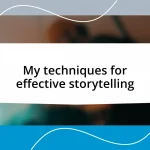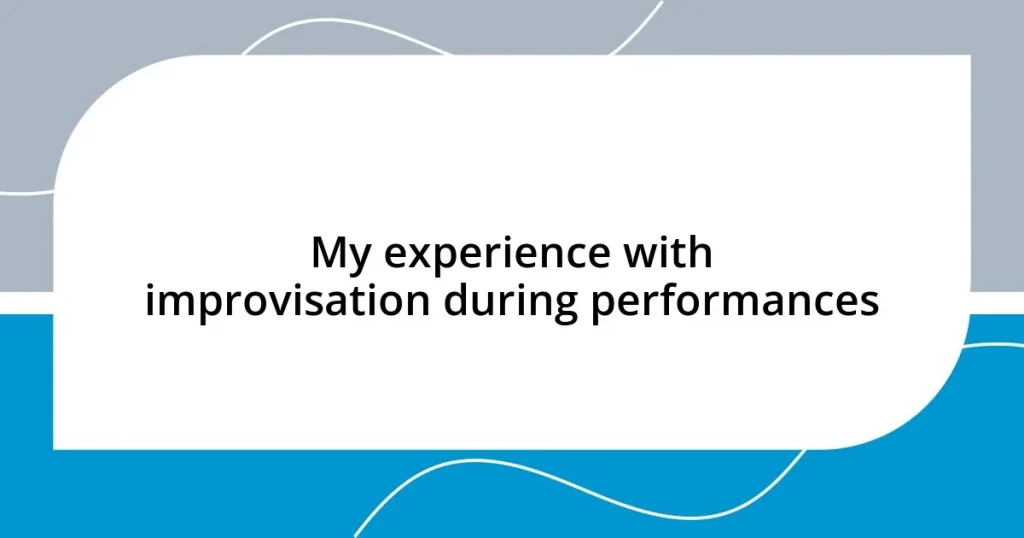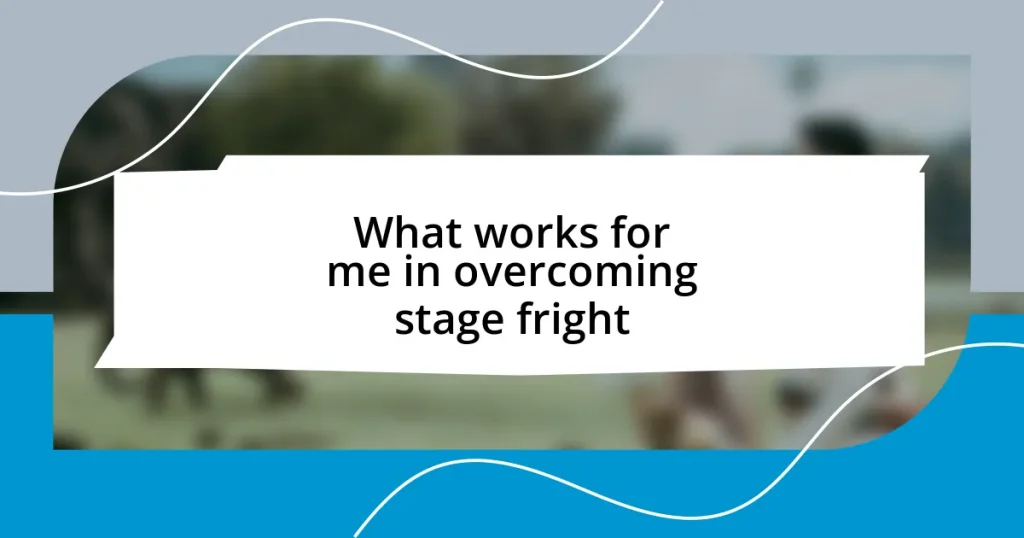Key takeaways:
- Improvisation fosters creativity and authentic expression, transforming unexpected moments into memorable experiences.
- Key techniques for successful improvisation include active listening, embracing mistakes, and staying present during performances.
- Building confidence can be achieved through regular practice, visualization, audience connection, and celebrating small wins.
- Reflection on performance experiences encourages growth and insight, highlighting the importance of connection over perfection.
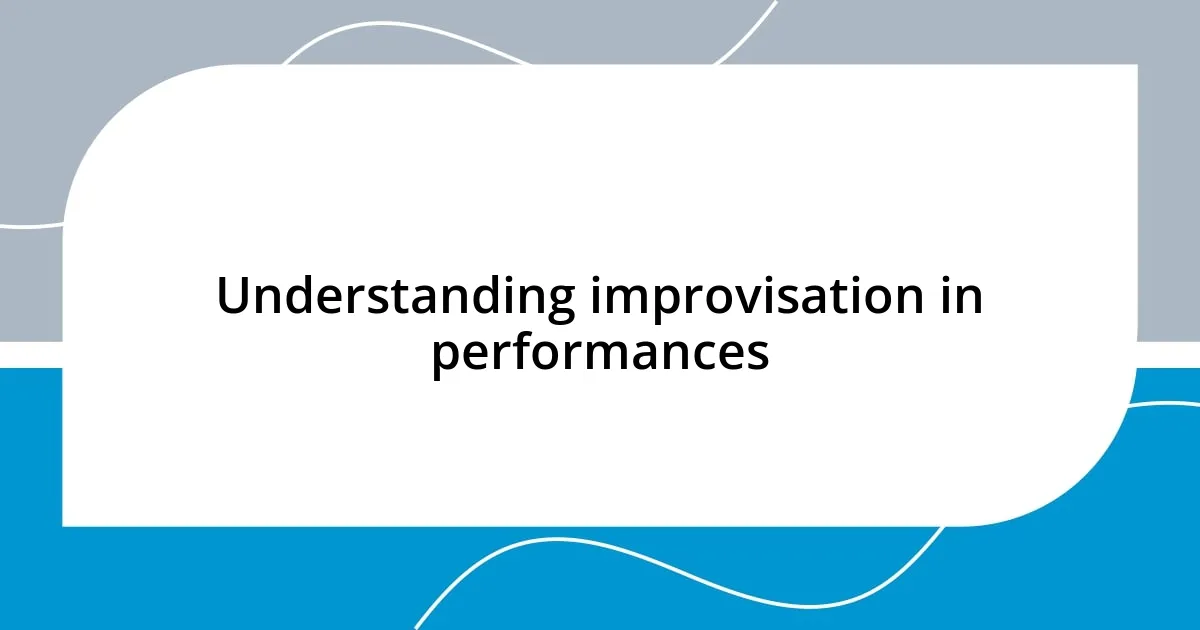
Understanding improvisation in performances
Improvisation in performances is like the heartbeat of live art; it fuels spontaneity and creativity. I remember a time on stage when a technical glitch left me hanging. Instead of panicking, I embraced the moment and created a whole new dialogue with my co-actor, which not only kept the audience engaged but also transformed a potential disaster into a memorable experience. Have you ever faced unexpected moments during a performance? It’s those instances that make improvisation so valuable.
Diving into improvisation often feels daunting, yet it opens doors to authentic expression. I recall rehearsing a scene that required a lot of precision, but when I decided to go off-script for a moment, I discovered a new layer of character that I’d been missing. This free-flowing approach not only reinvigorated my performance but also forged a deeper connection with my fellow actors on stage. Isn’t it fascinating how letting go can lead to something extraordinary?
In essence, improvisation is a conversation between the performers and the audience. In one of my performances, I noticed a shift in the crowd’s energy as I adjusted my lines based on their reactions. It was a beautiful reminder that performance art is dynamic and ever-evolving, often guided by the unseen current of audience engagement. How do you think your performance would change if you allowed for more improvisation? I’ve found that embracing unpredictability can lead to some of the most rewarding moments on stage.
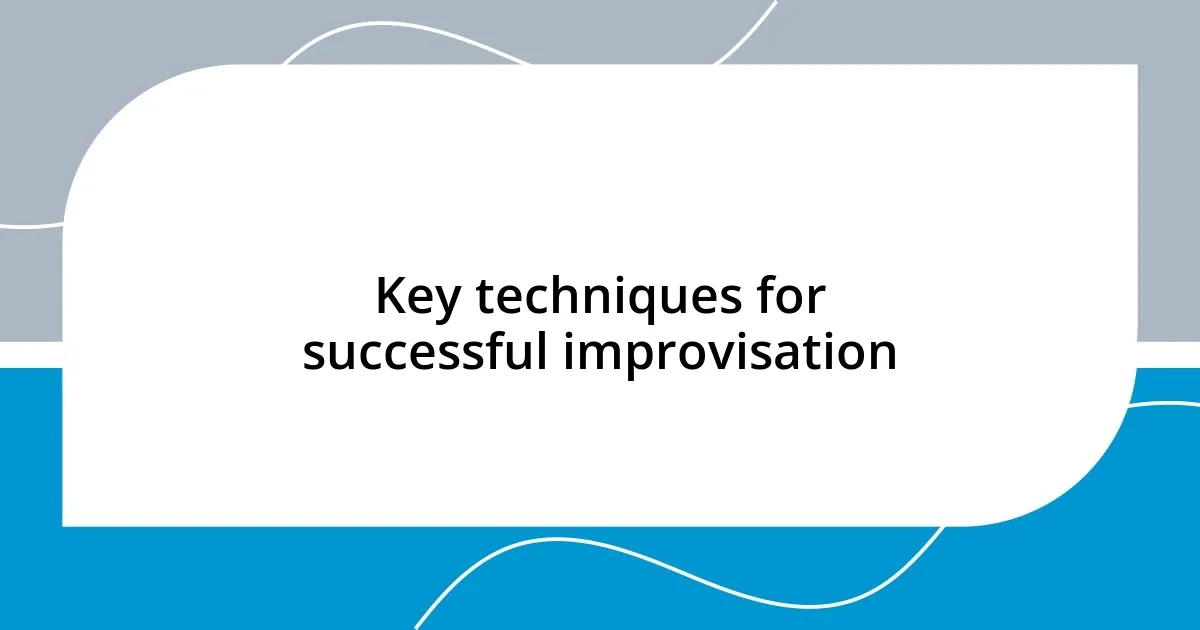
Key techniques for successful improvisation
When it comes to successful improvisation, one key technique is active listening. I remember an instance during a performance when my scene partner threw me a curveball by modifying their dialogue. Instead of sticking rigidly to my script, I tuned in fully and responded in a way that deepened the moment dramatically. This technique not only heightened my awareness but also fueled a rich exchange between us, keeping the audience on the edge of their seats. Have you experienced the magic that comes from really listening to your fellow performers?
Another important aspect is embracing mistakes. I once missed a line completely, causing a moment of silence that could have been awkward. Instead of retreating into embarrassment, I decided to playfully acknowledge the blunder. This choice transformed the moment and prompted laughter from the audience, creating a shared experience that brought us together. It’s funny how a small slip can often turn into the highlight of the show. Do you think that owning your errors can lead to unexpected joys?
Lastly, staying present is essential in improvisational performance. There was a particular night when everything felt off-kilter, and I found myself struggling to maintain focus. I took a deep breath, grounded myself in the moment, and allowed the unfolding drama to guide me. The energy shifted, and I was able to connect authentically with both the story and the audience. It’s in those moments that the true essence of performance shines through. What techniques do you find help you stay present when the pressure mounts?
| Technique | Description |
|---|---|
| Active Listening | Fully engage with fellow performers, responding dynamically to their choices. |
| Embracing Mistakes | Transform errors into opportunities for connection and humor within the performance. |
| Staying Present | Focus on the current moment to enhance authenticity and audience engagement. |

Building confidence for live performances
Building confidence for live performances can sometimes feel like a balancing act. I recall a particularly nerve-wracking show where I was on stage in front of an audience that felt overwhelmingly large. As the performance progressed, I used my nerves as fuel, transforming that anxiety into energy. With each line delivered, I grew more assured, discovering that confidence builds as you immerse yourself in the moment—it’s a fascinating synergy between performer and audience.
Here are some strategies I’ve found helpful for building that confidence:
- Practice Regularly: The more you perform, the more comfortable you’ll become on stage. Familiarity breeds confidence.
- Visualize Success: Before stepping onto the stage, I often close my eyes and visualize a successful performance. This mental rehearsal can ease anxiety and set a positive tone.
- Connect with the Audience: Establishing that bond can help diminish the fear of judgment. I’ve found that locking eyes with a friendly face in the crowd can be incredibly grounding.
- Prepare for the Unexpected: Knowing that anything can happen allows me to embrace surprises rather than fear them. This mindset creates a powerful sense of freedom.
- Celebrate Small Wins: After a performance, I take a moment to reflect on what went well, even if it’s a tiny aspect. Recognizing these victories boosts my confidence for next time.
By incorporating these tactics into my routine, I’ve noticed a significant shift in my confidence levels. This journey is as much about the process as it is about the performance itself.

Navigating challenges while improvising
When improvising, unexpected situations often arise, and how you navigate these challenges can define the performance. I remember one performance where the props failed to show up. Instead of panicking, I took a deep breath and made the most of what we had: our imagination. I turned to my scene partner and joked about how we were living in a “prop-less world.” The audience laughed, and we created a spontaneous narrative that thrived on our shared absurdity. Isn’t it incredible how limitations can spark creative solutions?
Distractions can be another significant hurdle. During one show, someone’s phone went off loudly in the middle of a tense moment. My instinct was to feel irritated, but I chose to acknowledge it instead. I paused, looked at the audience, and said, “Looks like we have a surprise guest!” The laughter that followed not only lightened the mood but also reinforced our connection with the audience. Have you ever noticed how embracing the unexpected can turn a challenge into a bonding experience?
Moreover, managing your emotional state while improvising is crucial. On one occasion, I felt a wave of self-doubt wash over me mid-performance. It was like a heavy fog threatening to derail everything. In that moment, I decided to show vulnerability instead of fighting it. I shared an impromptu line about my character’s insecurities, and it resonated deeply with the audience. This moment reminded me that revealing our humanity can create a strong bond with those watching. How do you handle your emotions when faced with unexpected turns in your performance?

Enhancing creativity through practice
Practicing improvisation has profoundly enhanced my creativity, often in surprising ways. I specifically remember a workshop where we were tasked with creating characters on the spot. At first, I felt hesitant—I wasn’t sure what to bring to the table. But as the night went on, I discovered that by letting go of the pressure to be “perfect,” I started drawing from my surroundings and personal experiences. In those moments, I found that creativity flows more freely when I focus on exploration rather than perfection.
One of the most impactful lessons I’ve learned is that repetition breeds innovation. While working on a piece, I’ve often run the same scene several times, each time allowing myself to try something new. Just last week, during a rehearsal, I decided to change my character’s reaction halfway through, opting for vulnerability instead of bravado. This unexpected twist not only surprised my fellow actors but also dynamically shifted the direction of our narrative. It’s incredible how something familiar can become a fresh canvas when we practice the freedom to explore new ideas.
Have you ever felt stuck, as if your creativity has hit a wall? I certainly have. On one particularly challenging day, I joined a group of fellow performers in a ‘yes, and’ exercise. We built off each other’s suggestions, and what began as a simple concept transformed into a compelling scene. This experience not only reminded me of the power of collaboration but also highlighted how much more creative I can be when I allow room for spontaneity. The journey of practicing improvisation truly reveals the magic of creativity waiting to be unleashed.

Reflecting on my performance experiences
Reflecting on my performance experiences, I often find myself revisiting those moments that initially felt daunting but ultimately transformed into valuable lessons. One time, I found myself on stage with a scene that had veered off script. Instead of sticking rigidly to what I had rehearsed, I leaned into the unexpected shift. I brought in a playful reflection of a situation from my own life, and to my surprise, it not only salvaged the moment but also deepened the audience’s engagement. Have you ever felt like embracing the chaos led to something more authentic?
There’s something profoundly pure about those performances where spontaneity reigns. I recall a moment when I delivered a line that was completely off-cuff—something I had never intended to say. The ripple of laughter that followed was both exhilarating and terrifying. I realized then that improvisation is like dancing in the moment; the more you let go, the more fluid the experience becomes. How many times have you let yourself be swept up in the rhythm of the unexpected?
Through my journey, I’ve come to appreciate the invaluable insights gained from reflecting on each experience. After a show, I often sit down and assess what worked and what didn’t. This practice has helped me identify patterns and cultivate a deeper understanding of my instincts. One illuminating reflection was recognizing that the most memorable moments usually arose when I prioritized connection over perfection. Isn’t it fascinating how vulnerability can lead to some of the most impactful interactions on stage?







